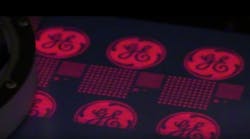The graph shows the 2002 LED market by application. Backlighting and signage comprised 17% and 10.3% of the total LED market respectively, and these segments, which mainly use HB-LEDs, offer the highest growth potential. The largest segments for standard-brightness LEDs were for status indicators and alphanumeric displays (37.5% of the total market) and IR transmitters (21.3%).
Rebello says that LEDs are particularly well suited for backlighting small LCD panels in cell phones, PDAs, digital cameras and camcorders. The market for larger panels - tablet PCs, laptop screens - is several years out, with the barrier being uniform illumination across large areas. The human eye requires a color uniformity of at least 95%.
iSuppli estimates that the backlighting market for LEDs will grow at a CAGR of 18% from around $500 million in 2002 to more than $1.1 billion in 2007. The market should be around $700 million in 2003. In handsets, the average number of LEDs per display is decreasing as LED performance improves; however, some phones now have more than one screen. The introduction of higher-quality cameras in phones might reduce the demand for stand-alone digital cameras, which would in turn reduce the demand for LED backlights in the latter application.






